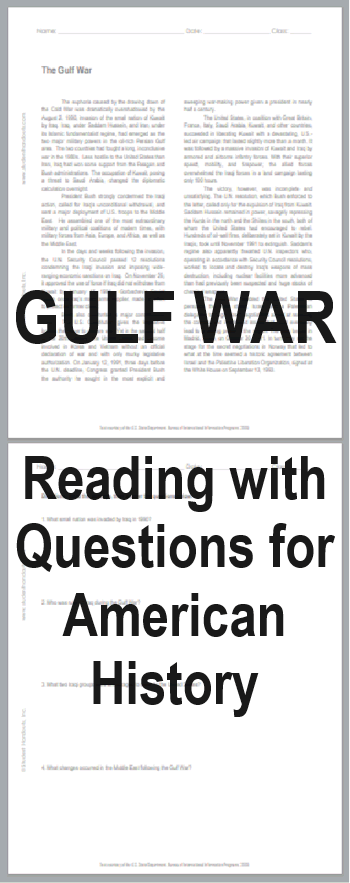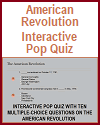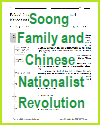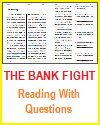| The Gulf War Reading with Questions |
|---|
| www.studenthandouts.com ↣ American History ↣ American History Readings |
The euphoria caused by the drawing down of the Cold War was dramatically overshadowed by the August 2, 1990, invasion of the small nation of Kuwait by Iraq. Iraq, under Saddam Hussein, and Iran, under its Islamic fundamentalist regime, had emerged as the two major military powers in the oil-rich Persian Gulf area. The two countries had fought a long, inconclusive war in the 1980s. Less hostile to the United States than Iran, Iraq had won some support from the Reagan and Bush administrations. The occupation of Kuwait, posing a threat to Saudi Arabia, changed the diplomatic calculation overnight.
 President Bush strongly condemned the Iraqi action, called for Iraq's unconditional withdrawal, and sent a major deployment of U.S. troops to the Middle East. He assembled one of the most extraordinary military and political coalitions of modern times, with military forces from Asia, Europe, and Africa, as well as the Middle East.
President Bush strongly condemned the Iraqi action, called for Iraq's unconditional withdrawal, and sent a major deployment of U.S. troops to the Middle East. He assembled one of the most extraordinary military and political coalitions of modern times, with military forces from Asia, Europe, and Africa, as well as the Middle East.In the days and weeks following the invasion, the U.N. Security Council passed 12 resolutions condemning the Iraqi invasion and imposing wide-ranging economic sanctions on Iraq. On November 29, it approved the use of force if Iraq did not withdraw from Kuwait by January 15, 1991. Gorbachev's Soviet Union, once Iraq's major arms supplier, made no effort to protect its former client. Bush also confronted a major constitutional issue. The U.S. Constitution gives the legislative branch the power to declare war. Yet in the second half of the 20th century, the United States had become involved in Korea and Vietnam without an official declaration of war and with only murky legislative authorization. On January 12, 1991, three days before the U.N. deadline, Congress granted President Bush the authority he sought in the most explicit and sweeping war-making power given a president in nearly half a century. The United States, in coalition with Great Britain, France, Italy, Saudi Arabia, Kuwait, and other countries, succeeded in liberating Kuwait with a devastating, U.S.-led air campaign that lasted slightly more than a month. It was followed by a massive invasion of Kuwait and Iraq by armored and airborne infantry forces. With their superior speed, mobility, and firepower, the allied forces overwhelmed the Iraqi forces in a land campaign lasting only 100 hours. The victory, however, was incomplete and unsatisfying. The U.N. resolution, which Bush enforced to the letter, called only for the expulsion of Iraq from Kuwait. Saddam Hussein remained in power, savagely repressing the Kurds in the north and the Shiites in the south, both of whom the United States had encouraged to rebel. Hundreds of oil-well fires, deliberately set in Kuwait by the Iraqis, took until November 1991 to extinguish. Saddam's regime also apparently thwarted U.N. inspectors who, operating in accordance with Security Council resolutions, worked to locate and destroy Iraq's weapons of mass destruction, including nuclear facilities more advanced than had previously been suspected and huge stocks of chemical weapons. The Gulf War enabled the United States to persuade the Arab states, Israel, and a Palestinian delegation to begin direct negotiations aimed at resolving the complex and interlocked issues that could eventually lead to a lasting peace in the region. The talks began in Madrid, Spain, on October 30, 1991. In turn, they set the stage for the secret negotiations in Norway that led to what at the time seemed a historic agreement between Israel and the Palestine Liberation Organization, signed at the White House on September 13, 1993. Directions: Read the text above, then answer the questions below. 1. What small nation was invaded by Iraq in 1990? 2. Who was ruler of Iraq during the Gulf War? 3. What two Iraqi groups were encouraged to rebel by the United States? 4. What changes occurred in the Middle East following the Gulf War? Click here to print this worksheet. Answers will vary. |
 |  |  |  |  |  |
| UNIT I: | Early America | UNIT IX: | Discontent and Reform | ||
| UNIT II: | Colonial Period | UNIT X: | War, Prosperity, and Depression | ||
| UNIT III: | American Revolution | UNIT XI: | New Deal and World War II | ||
| UNIT IV: | New National Government | UNIT XII: | Postwar America | ||
| UNIT V: | Westward Expansion | UNIT XIII: | Decades of Change | ||
| UNIT VI: | Sectional Conflict | UNIT XIV: | New Conservatism | ||
| UNIT VII: | Civil War and Reconstruction | UNIT XV: | Into the Twenty-first Century | ||
| UNIT VIII: | Growth and Transformation | UNIT XVI: | Polarization and Deglobalization |
| www.studenthandouts.com ↣ American History ↣ American History Readings |








